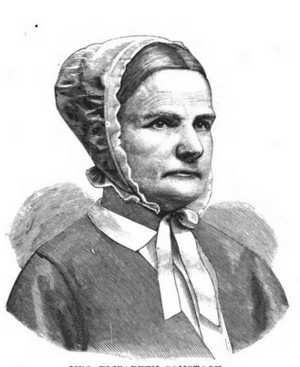Elizabeth Rous Comstock facts for kids
Quick facts for kids
Elizabeth Rous Comstock
|
|
|---|---|
 |
|
| Born |
Elizabeth Leslie Rous
October 30, 1815 Maidenhead, Berkshire England
|
| Died | August 3, 1891 |
Elizabeth Leslie Comstock (born October 30, 1815 – died August 3, 1891) was an important Quaker minister. She was also a social reformer, which means she worked to make society better. Elizabeth Comstock was an abolitionist, fighting to end slavery. She helped many people and worked to make the Quaker community fit into a changing world.
Elizabeth was a strong speaker. She taught people about those who were sick in hospitals and prison camps. During the American Civil War, she helped people who had just gained their freedom. Comstock played a big part in the Underground Railroad, running a busy safe house in Rollin, Michigan.
Her Early Life
Elizabeth Leslie Rous was born on October 30, 1815. Her parents were William and Mary Rous. She was born in Maidenhead in Berkshire, England. Elizabeth was the oldest of nine children. She went to Quaker schools in Islington and Croydon.
Starting Her Career
In 1847, Elizabeth married Leslie Wright. They moved to Bakewell in Derbyshire, where they ran a shop. After Leslie died, Elizabeth decided to move to Ontario, Canada. She moved with her sister and her daughter, Caroline. While living in Belleville, she became a Quaker minister.
Her Work for Change
In 1854, Elizabeth Comstock moved to Canada. There, she became a Quaker minister. Four years later, Comstock moved to Michigan in the United States. She quickly became active in the movement to end slavery.
Elizabeth Comstock became a leader for Quaker groups in southeastern Michigan. She ran the Rollin station of the Underground Railroad. This was a secret network that helped enslaved people escape to freedom.
During the Civil War, Comstock worked in hospitals and prison camps. She spoke out for prison reform. She gave talks in prisons, asking for prisoners to be treated kindly. She also spoke up for prisoners she believed were innocent. In 1864, she even met with President Lincoln. She talked to him about making prisons better.
After the Civil War, enslaved people were freed. Elizabeth helped them adjust to their new lives as citizens. She ran the Kansas Freedmen's Relief Association.
Her sister, Lydia Rous, came to the U.S. in 1866. Lydia had been working for a politician named John Bright. She met Elizabeth and helped in hospitals that cared for soldiers wounded in the Civil War.
After the war, Comstock kept working for many causes. She supported prison reform, which means making prisons fairer. She also worked for temperance (reducing alcohol use) and peace. She spoke up for women's rights and helped with welfare work in communities. She also helped people adapt to living in cities as more people moved there.
In 1879, Comstock traveled around the country. She raised money for the "Exodusters." These were many Black people who moved from the South to Kansas. Comstock was the secretary of the Kansas Freedmen's Relief Association from 1879 to 1881.
Her Family Life
In 1848, Elizabeth married Leslie Wright in Bakewell, Derbyshire. They had one daughter. Leslie died in 1851. After his death, Elizabeth, her daughter, and one of Elizabeth's sisters moved to Rollin, Michigan. In 1858, Elizabeth married again to John T. Comstock. He passed away in 1884.


